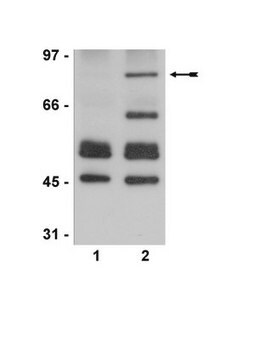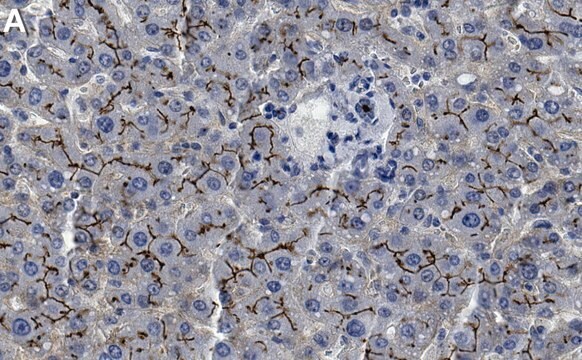06-916
Anti-acetyl-p53 (Lys373) Antibody
serum, Upstate®
Zaloguj sięWyświetlanie cen organizacyjnych i kontraktowych
About This Item
Kod UNSPSC:
12352203
eCl@ss:
32160702
NACRES:
NA.41
Polecane produkty
pochodzenie biologiczne
rabbit
Poziom jakości
forma przeciwciała
serum
rodzaj przeciwciała
primary antibodies
klon
polyclonal
reaktywność gatunkowa
human
producent / nazwa handlowa
Upstate®
metody
immunoprecipitation (IP): suitable
western blot: suitable
izotyp
IgG
numer dostępu NCBI
numer dostępu UniProt
Warunki transportu
wet ice
docelowa modyfikacja potranslacyjna
acetylation (Lys373)
informacje o genach
human ... TP53(7157)
Opis ogólny
p53 is a DNA-binding, oligomerization domain and transcription activation domain-containing tumor suppressor that upregulates growth arrest and apoptosis-related genes in response to stress signals, thereby influencing programmed cell death, cell differentiation and cell cycle control mechanisms. p53 localizes to the nucleus yet can be chaperoned to the cytoplasm by the negative regulator MDM2, an E3 ubiquitin ligase that is upregulated in the presence of active p53, where MDM2 polyubiquitinates p53 for proteasome targeting. p53 can assemble into tetramers in the absence of DNA, fluctuates between latent and active (DNA-binding) conformations, and is differentially activated through posttranslational modifications including phosphorylation and acetylation. Mutations in the DNA-binding domain (DBD) (amino acids 110-286) of p53 can compromise energetically favorable association with cis elements and are implicated in several human cancers.
Specyficzność
Recognizes p53 acetylated in vitro by recombinant p300, and for peptide containing acetyl-lysine 373 but not for the peptide containing acetyl-lysine 320; modest cross-reactivity for p53 acetylated in vitro by recombinant PCAF.
Immunogen
peptide corresponding to amino acids 367-379 of human p53 (SHLKSKACKGQSTSR, where ACK denotes acetyl-lysine).
Zastosowanie
Anti-acetyl-p53 (Lys373) Antibody is a Rabbit Polyclonal Antibody for detection of acetyl-p53 (Lys373) also known as Antigen NY-CO-13, Phosphoprotein p53, Tumor suppressor p53, p53 antigen & has been tested in IP & WB.
Jakość
routinely evaluated by immunoblot on GST-p53 acetylated by recombinant p300, HAT domain (Catalog #14-418) in an in vitro acetyl transferase assay
Opis wartości docelowych
53 kDa
Powiązanie
Replaces: 04-1137
Postać fizyczna
Protein A Purified immunoglobulin in 0.1M Tris-glycine, pH 7.4, 0.15M NaCl, 0.02% sodium azide, 0.1mg/ml BSA
Inne uwagi
Concentration: Please refer to the Certificate of Analysis for the lot-specific concentration.
Informacje prawne
UPSTATE is a registered trademark of Merck KGaA, Darmstadt, Germany
This page may contain text that has been machine translated.
Nie możesz znaleźć właściwego produktu?
Wypróbuj nasz Narzędzie selektora produktów.
Kod klasy składowania
10 - Combustible liquids
Klasa zagrożenia wodnego (WGK)
WGK 1
Certyfikaty analizy (CoA)
Poszukaj Certyfikaty analizy (CoA), wpisując numer partii/serii produktów. Numery serii i partii można znaleźć na etykiecie produktu po słowach „seria” lub „partia”.
Masz już ten produkt?
Dokumenty związane z niedawno zakupionymi produktami zostały zamieszczone w Bibliotece dokumentów.
Green tea polyphenols increase p53 transcriptional activity and acetylation by suppressing class I histone deacetylases.
Thakur, VS; Gupta, K; Gupta, S
International journal of oncology null
Hwei-Ling Cheng et al.
Proceedings of the National Academy of Sciences of the United States of America, 100(19), 10794-10799 (2003-09-10)
SIRT1 is a mammalian homolog of the Saccharomyces cerevisiae chromatin silencing factor Sir2. Dominant-negative and overexpression studies have implicated a role for SIRT1 in deacetylating the p53 tumor suppressor protein to dampen apoptotic and cellular senescence pathways. To elucidate SIRT1
A p53-CBP/p300 transcription module is required for GAP-43 expression, axon outgrowth, and regeneration.
Tedeschi, A; Nguyen, T; Puttagunta, R; Gaub, P; Di Giovanni, S
Cell Death and Differentiation null
Xiaowen Ge et al.
Frontiers in oncology, 11, 751904-751904 (2021-12-28)
Drug resistance remains a serious challenge to rituximab therapy in B-NHL (B cell non-Hodgkin's lymphoma). CDC (complement-dependent cytotoxicity) has been proposed as a major antitumor mechanism of rituximab, and direct abrogation of CD59 function partially restores rituximab sensitivity with high
Deacetylation of p53 after nerve growth factor treatment in PC12 cells as a post-translational modification mechanism of neurotrophin-induced tumor suppressor activation.
Vaghefi, H; Neet, KE
Oncogene null
Nasz zespół naukowców ma doświadczenie we wszystkich obszarach badań, w tym w naukach przyrodniczych, materiałoznawstwie, syntezie chemicznej, chromatografii, analityce i wielu innych dziedzinach.
Skontaktuj się z zespołem ds. pomocy technicznej








